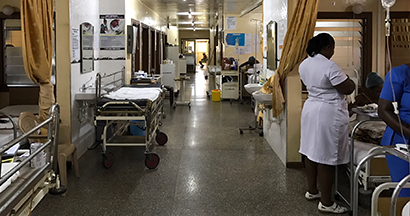

Author: Stacy W. Kish
A culture of safety at low- and middle-income hospitals in developing countries may increase the quality of post-surgery outcomes.
The Lancet Commission on Global Surgery found that over 5 billion people—more than half the number of people on the planet—lack access to safe, affordable surgical care. In the face of limited resources and personnel, a culture of safety and teamwork may translate to improved post-surgical care.
Researchers at University of Utah Health joined colleagues at the Ensign College of Public Health to evaluate the quality and safety of surgical care provided at the Volta River Authority Hospital (VRAH) in Akosombo, Ghana. The results were published online in August in the World Journal of Surgery.
Marta McCrum, MD, MPH, assistant professor of surgery at U of U Health, led an international team of researchers to identify ways low- and middle-income hospitals could optimize limited resources and establish a culture of safety to deliver high-quality surgical care to their patients.
“Global health research often concentrates on availability of resources,” said McCrum. “Our goal is to develop a culture of safety to promote and improve quality on its own.”
McCrum and her team used two survey instruments—The Safety Attitudes Questionnaire and The Hospital Consumer Assessment of Healthcare Providers and Systemsto evaluate VRAH staff and patients’ perception of the safety and quality of care, as well as the standardization of post-surgery procedures at the hospital. They obtained information from 31 staff and 15 patients.
Employees marked high points for job satisfaction, teamwork, and safety, with lower scores on stress recognition. Patients scored the hospital positively for pain management and nurse communication but lower for discharge information and medication communication.
“This is a great example that it is possible to provide high-quality care in a low-resource setting,” McCrum said. “Ensuring good working conditions and employee satisfaction can translate into improved patient care.”
McCrum cites several factors for the strong culture of safety within this hospital. The nurses and physicians take ownership of safety and follow flat hierarchies where everyone is empowered to speak up to ensure safe care without retribution from the hospital or its leadership.
The institution also adheres to the World Health Organization Surgical Safety Checklist, a series of tasks that occur before anesthesia, before the first incision, and before the patient leaves the operating theater. Finally, the staff use closed-loop communication, where a receiver repeats the requested task to reduce miscommunication.
McCrum acknowledges that this study is only a snapshot of activity during a two-week interval, but she believes that it does provide a good idea of how this particular hospital functions.
“By learning lessons at high performing hospitals, we are trying to identify lessons that can be translated to other hospitals facing similar resource challenges to build a culture that delivers quality care,” McCrum said.
In the 1960s, the neighboring hydroelectric Volta River Authority established the district hospital to provide medical care for workers and their families. The hospital maintains about 60 beds, providing care for about 1,000 patients a year. It also serves as the first point of entry for many residents into surgical care.
“Changing a culture is challenging and will take time, but the message of our paper is that resources should not be a barrier to receiving high quality care in low- and middle-income hospitals,” McCrum said.
McCrum was joined in this project by Katherine Smiley, Cindy Spangler, Samuel Finlayson, and Raymond Price at U of U Health; Rebecca Acquaah-Arhin and Love Ofori at the Volta River Authority Hospital; Deborah Deh, Juliana Enos, and Stephen Manortey at Ensign College of Public Health; and Frank Baiden at the London School of Hygiene and Tropical Medicine.